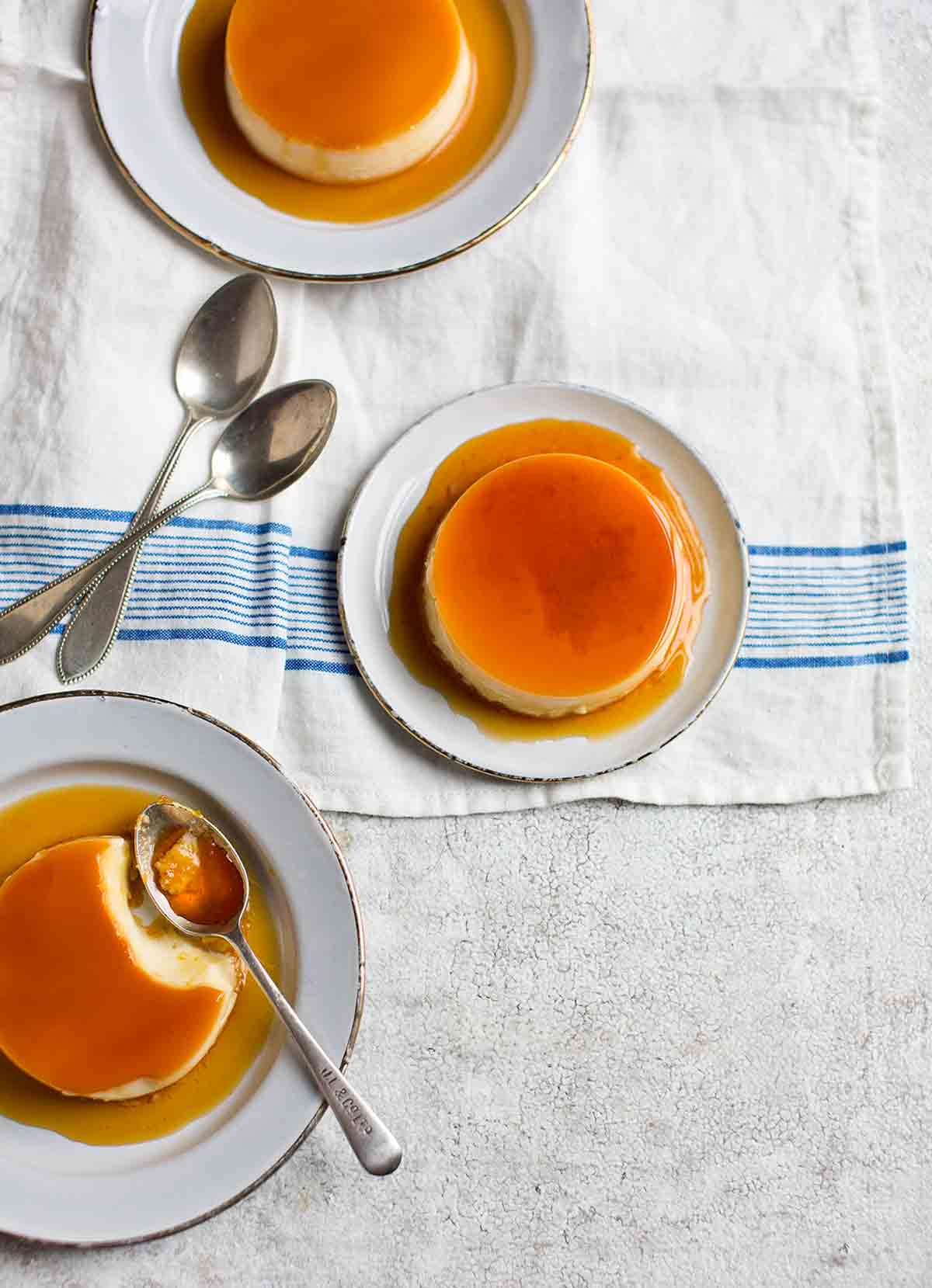
“I find this dessert such a simple comfort,” says author Edd Kimber. “Perhaps it is the memories of eating it as a child, or maybe it’s the texture.”
We can’t say for certain, either, exactly what the most compelling component of this crème caramel would be. We’re just grateful it exists in all its silken, sophisticated splendor. One taste, and we think you’ll concur.

Why Our Testers Loved This
Our testers were swooning over this creamy classic French dessert. They described the texture as “perfect” and loved the caramel and vanilla flavors lilting through the custard.
Chiyo Y. described it with her comment, “Simple, elegant, and delicious—if you haven’t had creme caramel in a while, you’ll enjoy being reintroduced to this unassuming classic.” Indeed!
What You’ll Need to Make This
- Superfine sugar–Finely ground sugar will dissolve easily and quickly, giving you a smooth caramel and custard. It’s available at most supermarkets, but you can easily make your own by grinding granulated sugar in a food processor or blender until finely ground but not powdery.
- Vanilla–You can use a whole vanilla bean or vanilla bean paste for your custard. You can substitute regular vanilla extract, but the vanilla flavor will be milder.
- Eggs–Use large or extra-large eggs for this recipe. They are necessary for the custard to set, so don’t try substituting smaller eggs.
How to Make This Recipe
- Heat the oven to 300°F. Set four ramekins in a roasting pan.
- Make the caramel. Dissolve the sugar in water and heat until the caramel is dark copper. Divvy between the ramekins.
- Warm the milk and cream over medium-low heat. Add the vanilla seeds and steep for about 5 minutes.
- Make the custard. Beat the sugar and eggs until pale, then slowly add the hot milk mixture. Divide between the ramekins.
- Bake the crème caramel in a water bath until almost set and reach an internal temperature of 170°F. Cool on a wire rack, then chill overnight.
Common Questions
The crème caramel can be baked and refrigerated for up to 3 days before serving. Keep refrigerated in their ramekins until ready to serve.
Both are French custard-based desserts. When turned out, crème caramel has a layer of runny caramelized sugar syrup on top. In contrast, crème brûlée is topped with a layer of granulated sugar that’s torched or broiled to crystallize the sugar into a hard caramel layer.
Gently run a knife around the edge of your ramekin. Place a plate upside down over the ramekin. Then using both hands, invert the plate and ramekin together so that the molded custard gently plops out onto the plate. Allow all of the caramel syrup to drizzle over the custard before serving.
Helpful Tips
- Immediately remove the pan from the heat when it turns a dark copper color. Caramel can burn very quickly.
- Crème caramel can be stored in their ramekins in the refrigerator, and covered with plastic, for up to 3 days.
- This recipe is suitable for gluten-free diets.
Write a Review
If you make this recipe, or any dish on LC, consider leaving a review, a star rating, and your best photo in the comments below. I love hearing from you.–David
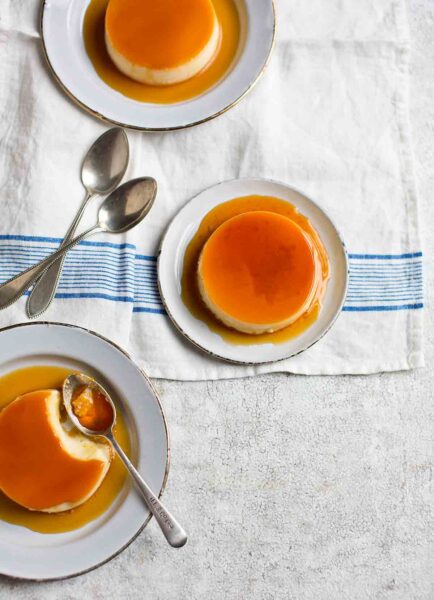
Crème Caramel
Equipment
- Deep-fry or candy or instant-read thermometer
Ingredients
For the caramel
- 1/2 cup superfine sugar (or just blitz granulated sugar in a blender until finely ground but not powdery)
- 3 tablespoons cold water
For the custard
- 1 vanilla bean or 2 teaspoons vanilla bean paste
- Generous 1 1/2 cups whole milk
- 3 1/2 tablespoons heavy cream
- 4 large or extra-large eggs
- Scant 2/3 cup superfine sugar
Instructions
Prepare the oven and ramekins
- Preheat the oven to 300°F (150°C). Place four 3 1/2-inch ramekins (or heatproof containers of a similar size) in a roasting pan.
Make the caramel
- Put the sugar and water in a small pan over medium-high heat, stirring occasionally, until the sugar has dissolved. Once the syrup is clear, stop stirring (this can cause crystallization) and let the pan remain over the heat, without touching it, until the sugar caramelizes, which may take anywhere from 4 to 7 minutes. The second that you have a caramel with a dark copper color, remove the pan from the heat and immediately pour it evenly among the prepared molds. (Be careful that the caramel doesn’t cook too far as it can burn easily.) Let the caramel puddles sit while you make the custard.
Make the custard
- Cut the vanilla bean, if using, in half and scrape out the seeds. Place the seeds or vanilla bean paste in a medium pan and add the milk and cream. Heat gently over medium-low heat until the mixture is hot but not boiling, 5 to 7 minutes.
- Meanwhile, place the eggs and sugar in a bowl and beat together until pale. Once the milk mixture has come to temperature, remove the pan from the heat and slowly pour the mixture over the eggs, stirring constantly.
- Using a ladle, divide this custard equally between the prepared ramekins. Put the roasting pan in the oven and add enough cold water so that it reaches halfway up the sides of the molds.
- Bake for 30 to 45 minutes, until the custards have set around the outside but still have a wobble in the center and register 170°F to 175°F (76°C to 79°C) on a deep-fry or candy or instant-read thermometer.
- Carefully remove the roasting pan from the oven. Lift out the custards and put them onto a wire rack to cool. Cover each ramekin with plastic wrap then transfer them to the refrigerator to chill overnight.
- To serve, use a knife to gently loosen the custards from the ramekins. Place a serving plate on top of each ramekin and invert it to turn the custards out. Make sure all the caramel drains from the ramekin onto the custard. Serve.
Notes
- Don’t burn the caramel–Immediately remove the pan from the heat when it turns a dark copper color. Caramel can burn very quickly.
- Storage–Crème caramel can be stored in their ramekins, in the refrigerator, covered, for up to 3 days.
- Dietary–This recipe is suitable for gluten-free diets.
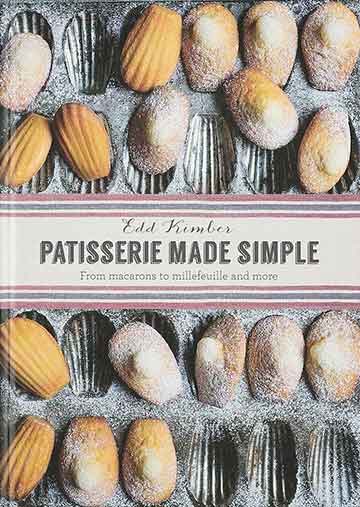
Nutrition
Nutrition information is automatically calculated, so should only be used as an approximation.
Recipe Testers’ Reviews
I’ve made crème caramel many times, and this is one of the best versions I’ve had.
I used 3-inch ramekins and was able to fill 6 of them. The texture of the custard was pretty much perfect. It was firm but creamy, and the vanilla flavoring came through perfectly.
Be sure to take the pan off the stove as soon as the caramel appears to be turning the correct color, or in just a few more seconds, it’ll become burnt and bitter. Also, to prevent the caramel from continuing to cook, immediately pour it into the ramekins.
I served this with a dollop of freshly made whipped cream. In berry season, I’ll add a few fresh blueberries or strawberries to the plate. I used large eggs, and they worked fine.
A classic recipe that’s easy to prepare. It has to be made in advance, which I always think is convenient. No stressing with dessert, and it’s absolutely delicious. It’s a keeper.
Regular large eggs worked just fine. I used a vanilla bean and added the pod and the seeds to the milk. I let it come to a simmer, which took 5 minutes, and then steeped for 15 minutes. I poured the mixture through a coarse sieve to catch the pods.
It took me longer to bake the custard than stated in the recipe. After 30 minutes, it was still very liquid. It started to set after 40 minutes, and I pulled the molds from the oven after 50 minutes. It’d probably help to add hot water instead of cold in the beginning.
I had no problems whatsoever when it came to serving the creme. I just slid a small knife along the rim, and they came out after inverting. Plenty of sauce.
Simple, elegant, and delicious.
If you haven’t had crème caramel in a while, you’ll enjoy being reintroduced to this unassuming classic. The layered sweetness in the caramel and custard and the aroma of vanilla are a delightful combination.
What I like about this creme caramel recipe is it skips two steps typically seen in flan recipes–1. putting the liquid custard through a sieve and, 2. boiling water for the roasting pan. The results didn’t suffer at all.
The custard baked evenly (it took 40 minutes in my oven) and came out perfectly silky and smooth. After you invert the ramekin, hold it firmly and give it a gentle jiggle, and the creme caramel will release easily. I used extra-large eggs.
My ramekins are 3 1/2 inches in diameter and 1 3/4 inches high; their capacity is 6 ounces each. The custard filled the ramekins almost to the top, which scared me a bit. But it turned out to be fine, as the custard didn’t increase in volume during baking—no spilled mess. It just made moving them into the oven challenging.
The custard took 40 minutes to set. It had formed a thin layer on the top that was drier (but not hard), and I didn’t see the center wobble very much as the recipe suggests. A quick search revealed that the internal temp should be 170 to 175°F for flan. Mine had hit 172°F when I took it out of the oven, and the texture of the custard was just perfect.
The way my mother spoke about creme caramel, it was the classiest dessert, though the author here describes it as the most basic of baked custards.
When I saw the recipe pop up, I’ll admit I thought it was old-fashioned and dated. Still, those feelings were overridden by classy, nostalgic, and homey memories, and I went ahead.
I used the best available ingredients, thinking that with so few, each one really counts. I used superfine sugar, a beautiful vanilla bean, superior-quality whole milk and heavy cream, and extra-large eggs, plus precisely the 3 1/2-inch ramekins called for.
After chilling overnight, the taste test was a unanimous success. Heavenly!
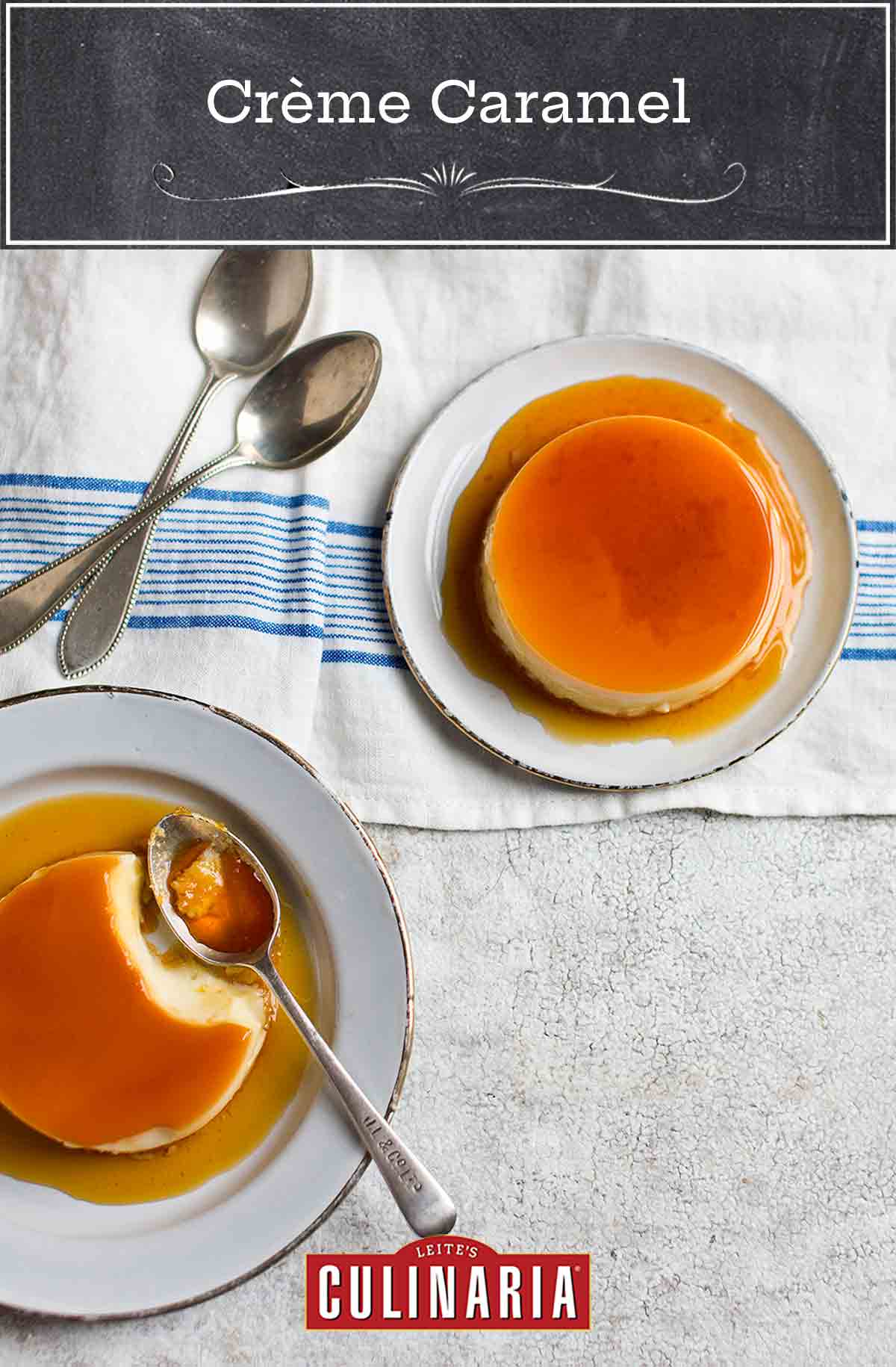

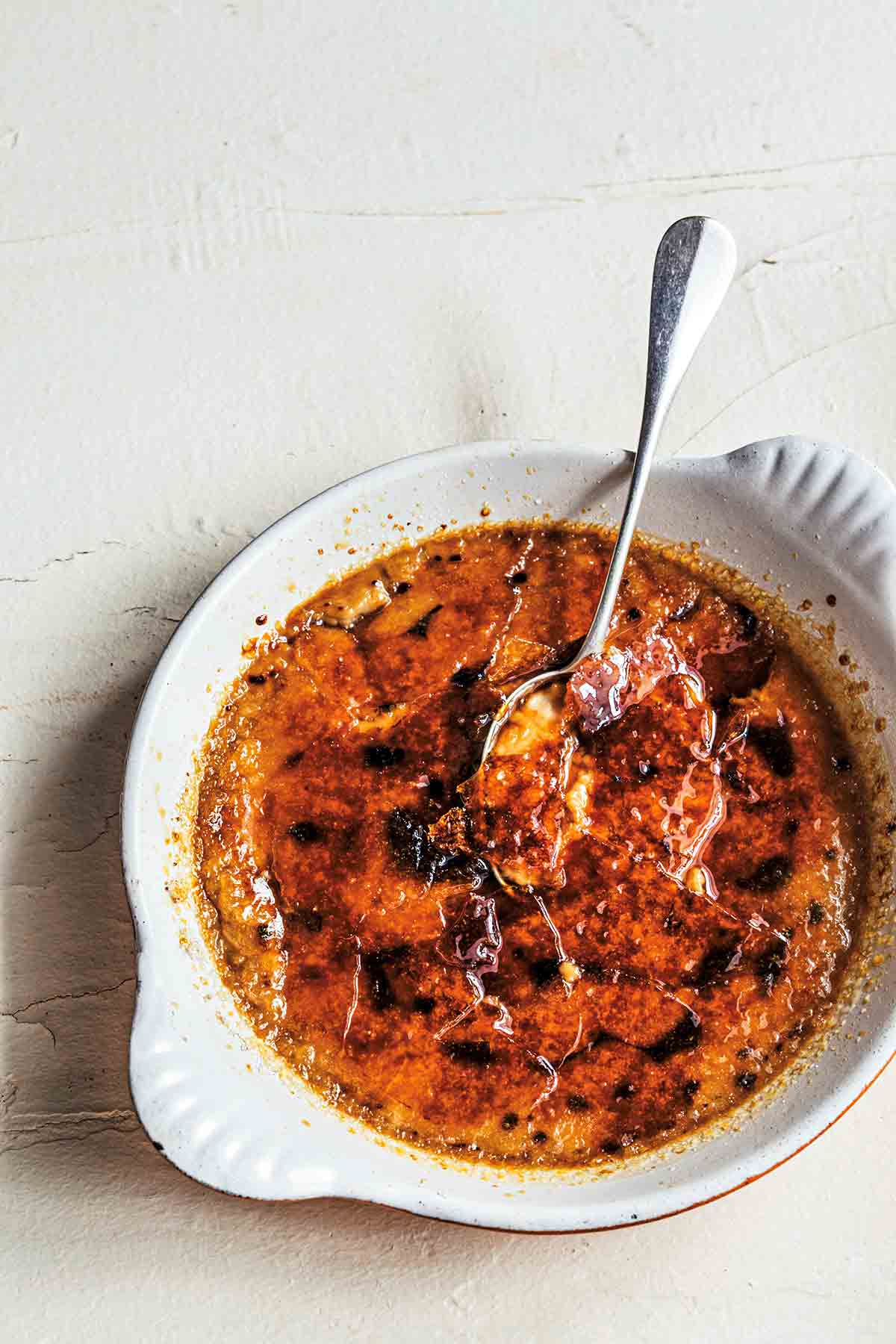




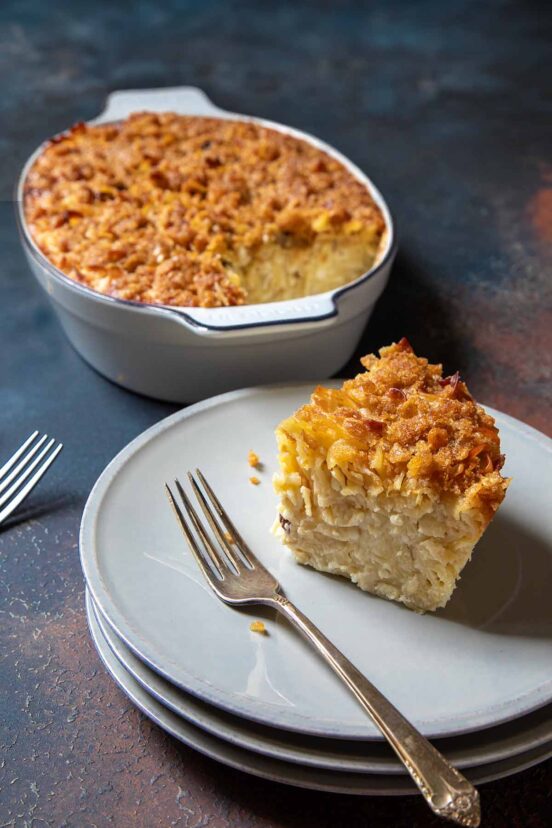
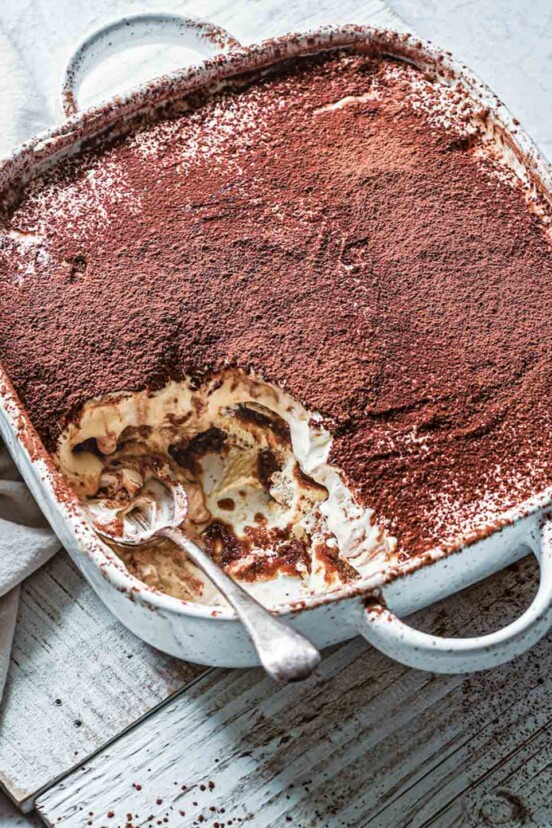
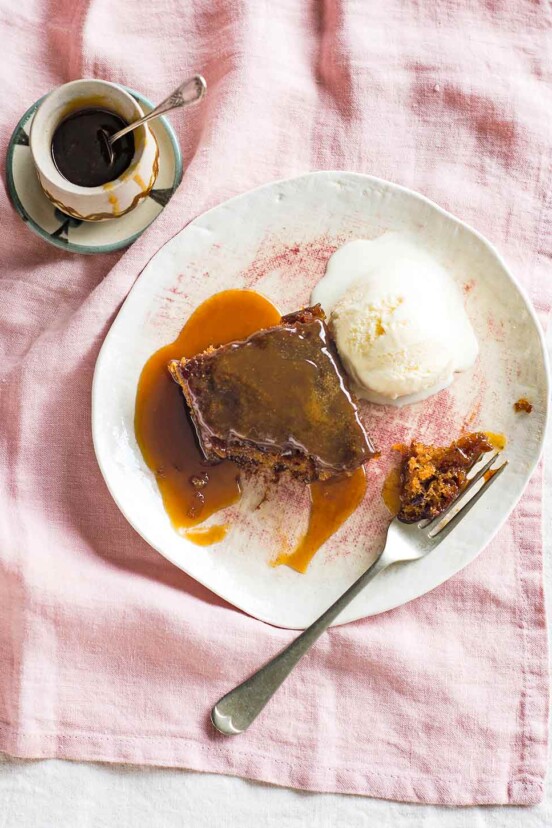









I followed the recipe to a tee but mine did not set at all! I baked it for 50 min and it was still super liquidy but I figured it would set in the fridge. Well, it’s been in the fridge for 18hrs and it’s pure liquid. What did I do wrong? My eggs were homegrown fresh eggs so perhaps not quite extra large but by no means small.
Hi Grace, did you confirm the custards were at the target temperature before removing them from the oven?
Are you sure the amount of sugar in the custard (125g) is correct? I made this today and found it too cloying to be edible. I looked at other recipes for creme caramel and for the same yield they only call for 1/4-1/3 of the sugar in this recipe. If I make this again, I will only add about 40g sugar and see how it turns out.
Tess, I’m sorry to hear the custard was overly sweet for your tastes. Actually, yes, that is the amount of sugar called for in the original recipe and it’s the amount of sugar which our recipe testers used when they made and loved this creme caramel. (You’ll find their comments beneath the recipe.) I guess it comes down to personal preference. I’d love to hear what you think when you try it next time with the reduced amount of sugar.
Made this, this weekend! Sheer genius!
Right?! So glad to hear you like it as much as we do, Sauertea! It just may be our fave dessert ever…